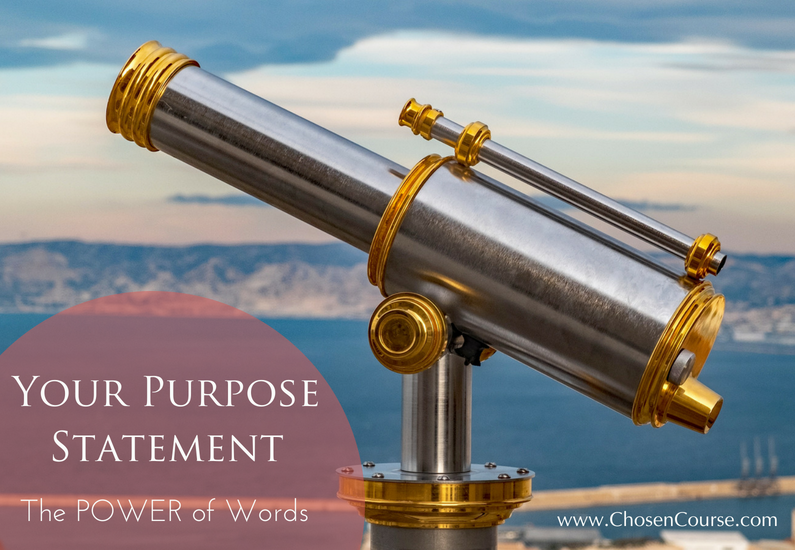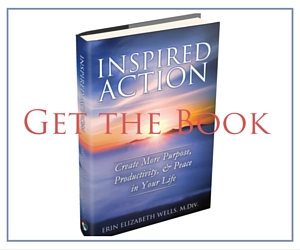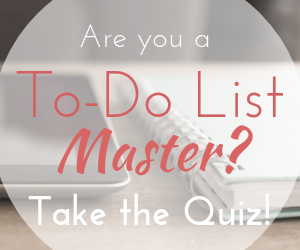A few weeks ago I shared the chapter about when purpose changes from my book Inspired Action: Create More Purpose, Productivity, & Peace in Your Life. Most of us know that our lives shift from time to time. I often say that our lives move in chapters. Whatever chapter you’re in, it can benefit and be strengthened by crafting a specific purpose statement.
So, if you’re ready to give yourself a powerful, purpose-focused tool…
Chapter 4: Your Purpose Statement
Have you ever noticed that what you focus on expands? Focus on a problem, and everything becomes about the problem. Focus on a joyful experience, and everything feels joyful. Wouldn’t it be great if you could just push a button and experience the beautiful feeling of being connected to your purpose? What if we helped you install that button?
Your Purpose Connection Button requires two ingredients:
- A clear purpose statement (The experience being triggered.)
- A charged emotional anchor (The button to be pushed.)
Your Purpose Statement
There’s power in words. The more you focus the language of your purpose, the deeper your understanding and experience of it will become. Consider the mantras, or repetitive ritual words, that are used in most of the major spiritual traditions. Christians say the rosary or the Our Father. Buddhists and Hindus have rhythmic ritual mantras for meditation and prayer. In the Jewish tradition, I remember the beautiful intensity of the ritual words to commence the Seder dinner that my uncle, Calvin, would speak.
At first your purpose may emerge as a general sense of who, what, and where you want to impact, but a general sense will never carry you as far on a daily basis as a strong, clear purpose statement can. Choosing specific words to connect you clearly to your purpose can be an act of setting a spiritual intention. Regardless of your spiritual or religious background, with these words you will manifest your highest understanding of your life’s purpose each time you speak them. The effort of clearly defining these words will pay off greatly over time.
Elements of a Purpose Statement
A strong purpose statement includes two parts:
- A specific statement of whom or what you are working for or with
- A defined outcome—the result or benefit of following your purpose
Based on these elements, the formula for an effective purpose statement is as follows:
I + [verb] + [group of people or focus of work] + so that + [outcome].
Here are some examples:
- I care for animals that have been abandoned so that they will be restored to health and joy.
- I craft our company’s message so that we can serve and improve the lives of even more people.
- I teach children so that they will stay curious and develop their love of learning.
- I lead the people on my team brilliantly so that we can create the best products for our customers.
- I love and nurture the elderly so that they can live with care and dignity in their final years.
- I do improv comedy and teach acting so that I can bring joy and fun to people’s lives.
- I create awareness of how we all can take better care of our planet so that we and our children can live more sustainably with the Earth.
Here is my own purpose statement:
I teach ambitious entrepreneurs how to connect with purpose and create the systems, habits, and mindsets to manifest that purpose in their everyday lives.
The Benefits of a Purpose Statement
A clear and congruent purpose statement will help you do the following things:
- Focus your decisions and actions on a daily basis. Your purpose statement helps you decide which actions are really essential on a daily or weekly basis. It gives you a clearer way to answer the question, “Does this task or project support or align with my purpose?”
- Measure your progress and success. Your purpose statement gives you a way to gauge your progress during quarterly and annual reflection times (see Chapters 47 and 48). During these reflections you will ask, “How much of my energy and time am I dedicating to my purpose? How can I make further progress? What will be my next measure of success? What project should be my next major focus?”
- Communicate clearly and gain associates and allies. A well-crafted purpose statement is easy to communicate to others. How many times in your life have you been asked, “What do you do?” What if you could surprise your conversation partner by saying, “I work with corporations so that they can be better stewards of our planet”? Isn’t that a more compelling answer than “I’m an environmental consultant”? You never know when the person you’re talking with might become an advantageous partner or ally on your path.
- Ritually renew your commitment to your purpose. I began this chapter by comparing a purpose statement to a mantra. One of the most powerful benefits of having a clear purpose statement is your ability to repeat it easily and frequently to yourself and to others. A daily reminder of the work that comes from your core will both help you through the rough times and feed your energy for all sections of your journey.
Create and Charge Your Emotional Anchor
Your emotional anchor is the second ingredient for your Purpose Connection Button. It is a symbol of your purpose that triggers the feeling you get by connecting to that purpose. An emotional anchor can be anything—a physical object, such as a piece of jewelry; a part of your body that you touch or bring your hand to, like your heart; or a movement, such as a fist pump. One of my clients chose to squeeze the index finger of her right hand, which became her magic finger to evoke the powerful emotional state she needed to stay on course. I encourage you to make your anchor something accessible that you will either keep with you or be able to repeat whenever you need it.
Once you’ve chosen an anchor, it’s time to charge it up. You can go to www.InspiredActionBook.com/Resources and listen to our Purpose Connection Button audio exercise for help with this process, or you can read the following instructions:
- Take a couple deep breaths, relax, and close your eyes.
- Notice how easily you can remember a time when you felt unstoppable—when you were certain that you would succeed. Bring that experience into your mind and body as if it were happening right now. Breathe how you were breathing at that time, feel what you were feeling, see what you were seeing, and hear what you were hearing. Drop back fully into that moment.
- Make the moment bigger, brighter, crisper, and clearer. Bring the feeling of being unstoppable up to a peak. You are completely certain that you can succeed at whatever is in front of you. Now, pour that feeling into your anchor. Touch the object or part of your body, or make your anchor gesture. Feel the connection. Charge your anchor with that emotion. When you feel it connect or click in, take a deep breath and clear the screen mentally and emotionally. Come back to the present moment.
- Now, how easily can you remember a time when you felt completely clear and focused on your task. Do you remember that? You were in flow, and the world dropped away, leaving you clicking away easily on the project at hand. Drop into that moment fully, as if it were happening right now. Breathe how you were breathing, feel what you were feeling, see what you were seeing, and hear what you were hearing.
- Again, make the moment bigger, brighter, crisper, and clearer. You are so clear, so focused, and everything is just moving along easily. Raise the feeling to a peak, and then pour that feeling into your anchor. Touch the object or part of your body, or make your anchor gesture. Feel the connection. Charge your anchor with that emotion. When you feel it connect or click in, take a deep breath and clear the screen mentally and emotionally. Come back to the present moment.
- Finally, notice how easily you can remember a time when you felt like joy and excitement were just pouring out of you. Can you remember that? Bring yourself fully into that experience of complete joy and excitement. It’s filling you up and radiating out of you. Drop fully into that moment as if it were happening right now. Breathe how you were breathing, feel what you were feeling, see what you were seeing, and hear what you were hearing.
- One last time, make the moment bigger, brighter, crisper, and clearer. The joy and excitement are thrumming through your whole body and vibrating out of you. Raise the feeling to a peak, and then pour that feeling into your anchor. Touch the object or part of your body, or make your anchor gesture. Feel the connection. Charge your anchor with that emotion. When you feel it connect or click in, take a deep breath and clear the screen mentally and emotionally. Come back to the present moment.
- Now bring the two parts together. Touch your anchor object or make your anchor gesture and feel the focused, certain, unstoppable joy rise and wash over you and fill your being. When you feel those emotions flowing through you, say your purpose statement, either aloud or in your mind. Speak it with certainty, power, and joy. Surround it with those feelings, and perhaps even repeat it and your anchor gesture once or twice more. Feel them connect, and know that whenever you want to evoke these emotional states and connect to your purpose, all you need to do is to touch or repeat your anchor and open yourself to reconnecting with this moment right now: focused, certain, unstoppable joy for your purpose. It’s waiting for you at your fingertips.
Next Actions
- Draft your purpose statement. Play with active and vibrant verbs. Define your target audience or focus even more specifically. Make your outcome compelling. Make your purpose statement easy to say and to remember.
- Make pressing your Purpose Connection Button a daily practice. Charge your anchor; feel the emotion of focused, certain, unstoppable joy flow into you; and speak your purpose statement. Start your day with it; do it as soon as your feet hit the floor, or before you walk out your door in the morning. Hit your purpose connection button before you walk into that important meeting or conversation. The more you use it, repeatedly and intentionally, the stronger it will become.
- If you find yourself naturally feeling an emotion that you’d like to connect to your purpose, then charge your anchor at that moment and stack the emotion into your Purpose Connection Button. Build the feeling up, bring it to a peak, and feel it connect to your anchor.
- When someone asks you what you do, experiment with telling him or her your purpose statement rather than stating your company, position, or title. You might discover fascinating people and have great conversations because you give people a sense of your core rather than just the outer-world titles and trappings.
- Look over your plans for the day or week and ask yourself, “How do these plans support my purpose?” You don’t have to align every action you take to your purpose, but if you aren’t taking purpose-aligned actions regularly, you may discover that you’ve lost momentum and focus.
Want more?
If you want more great, actionable strategies to address you challenges around energy management, task management, getting organized, and team collaboration, then you’ll want to pick up a copy of Inspired Action: Create More Purpose, Productivity, and Peace in Your Life. The book offers 50 short chapters with specific, action-oriented strategies that can make a huge difference in your life.




